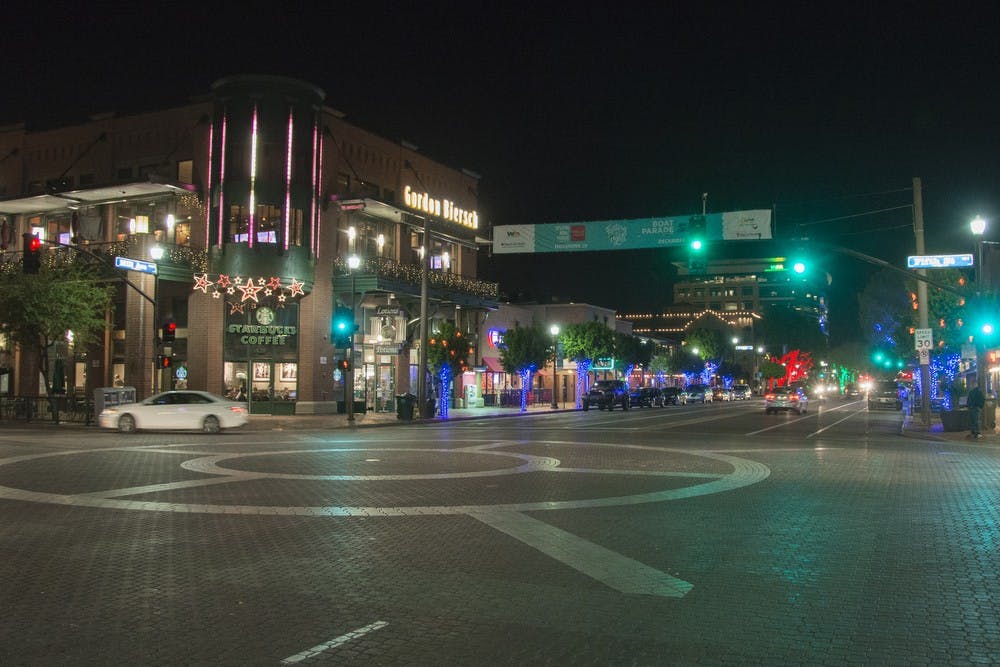Students who are angry about parking in Tempe have no shortage of reasons to be frustrated, but the current parking shortage represents the first step forward in remaking one of the world’s most famously sprawled cities.
Moving forward, Tempe has to figure out how to balance the city’s facelift with commuting students’ needs.
Plenty of frustration has been voiced over the loss of parking options near the Tempe campus, including the lot at the corner of University Drive and Forest Avenue.
While getting close to campus may be harder, it will benefit us all to have a denser downtown Tempe, which is the goal of replacing parking with actively-used space.
The City of Tempe’s General Plan 2040 documents put forward a vision of a renewed downtown Tempe, far beyond the Mill Avenue bars students know today. Tempe's expanding skyline demonstrates the focus on constructing denser housing, including developments on the rapidly changing southeast corner of Tempe campus.
This vision, however, also reduces parking for students commuting to campus by car. Increasing density allows for more students to be housed closer to campus, though the focus on luxury housing puts into question which students that includes.
Commuter students, for financial reasons or not, are at a disadvantage if they continue to come to ASU via car.
The City of Tempe is not as as involved with campus issues. “There is a difference between City of Tempe right-of way and ASU right-of-way,” said Mackenzie Keller, spokesperson for the Tempe City Manager’s Office.
That means that ASU Tempe gets its own special planning area that the City of Tempe doesn’t control as strongly. Essentially, Tempe is moving forward whether ASU plans for a public transit-centered community or not. Toward that end, though, there is movement.
ASU Parking and Transit Services is pushing sustainability initiatives including reducing parking demand on campus. Eco Passes and encouraging carpools can reduce car reliance, but will only succeed with greater student buy-in, meaning that things will start changing as parking gets harder near and on campus.
The loss of parking, while temporarily annoying, comes with massive benefits for students once they arrive on campus, including walkable communities put forward by initiatives like the Transportation General Plan.
For 2040, the plan largely responds to increased demand for transportation by improving pedestrian, bicycle and transit access, with some arterial streets seeing reductions in vehicle traffic lanes.
Jeff Speck: Four Road Diets from Cupola Media on Vimeo.
This transition is a necessary paradigm shift for one of America’s smoggiest cities. While some of Phoenix’s air quality problems come from dust blowing from the desert, Phoenix is also 10th in the nation for smog-related ozone production, largely from our transportation network.
What’s better, the walkability movement’s bible, The Death and Life of Great American Cities, argues that walkable areas create better, self-sustaining communities where people want to stay around.
The transition between 2017 and 2040 is going to be difficult, especially with questions over the state of funding with an unpredictable Department of Transportation under Ellen Chao and a Department of Housing and Urban Development under neurosurgeon Benjamin Carson, M.D.
Nevertheless, our car-reliant student body should begin planning alternative routes to campus.
Those commuting between ASU Tempe and other suburbs are going to feel greater pressure to change their habits, but at ASU we’re prepared to deal with changing situations. This will just force us to learn to be number one in transportation innovation.
Reach the columnist at benjamin.steele@asu.edu or follow @blsteele17 on Twitter.
Editor’s note: The opinions presented in this column are the author’s and do not imply any endorsement from The State Press or its editors.
Want to join the conversation? Send an email to opiniondesk.statepress@gmail.com. Keep letters under 300 words and be sure to include your university affiliation. Anonymity will not be granted.
Like The State Press on Facebook and follow @statepress on Twitter.




